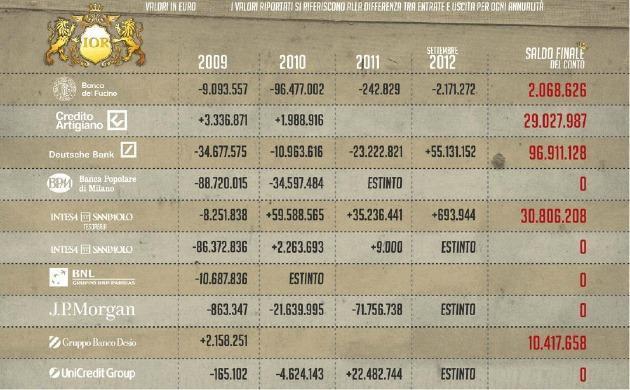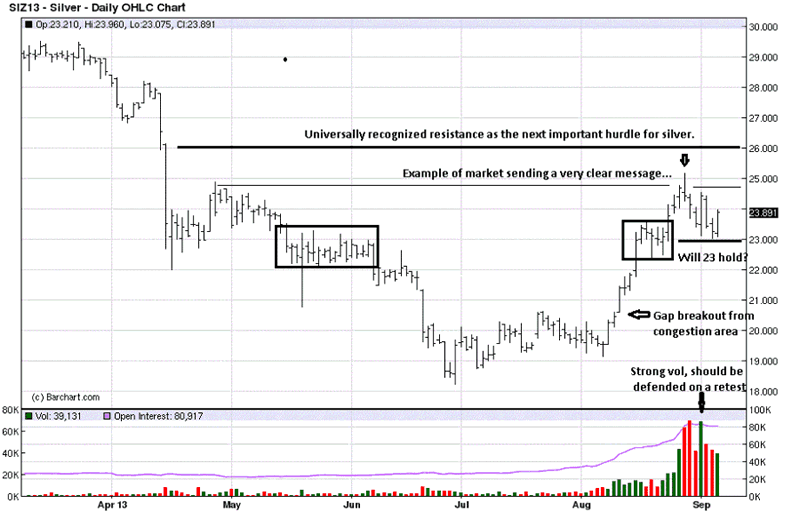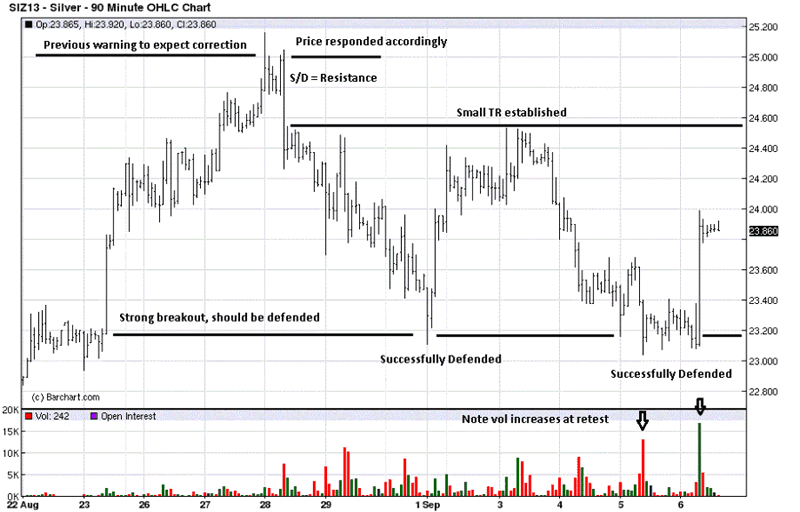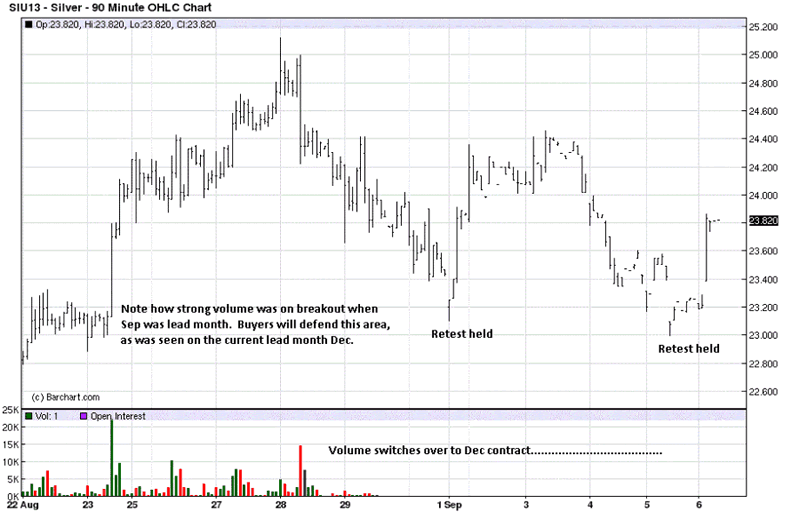by Jeff Miller
Last week I predicted that we would see volatility without clarity. The market concerns include Syria, changes in Fed policy, the nomination for Fed Chair, and the debt ceiling, roughly in that order. We got the employment report, the last big piece of economic data before the FOMC meeting, and plenty of speeches and pundit pontification. What do we know? Nothing more than we did a week ago! This looks like a victory on the cloudy crystal ball front.
My volatility prediction was also accurate. While the stock market week was positive, the ride was pretty wild, as you can see from the weekly chart.

The early Tuesday gains had a short life, with reports of missile tests in the Mediterranean. Wednesday clawed back gradually, and Thursday was one of the quietest days of the year. Friday deserves special attention, so let us turn to Doug Short's great chart and explanation:

There was an initial positive reaction to the employment number, a comment by Putin, and then more commentary from Obama and others at the G20 meetings. This is the essence of volatility driven by headlines.
The Week Ahead
The story line for the coming week will be all about Syria. There is little new economic data, The FOMC meeting is more than a week away and FedSpeak is in a quiet period. The market will gyrate with each piece of news about Syria, so what should we be watching?
As always, I am not writing about what the policy should be. As citizens, we all can and should have an opinion. As investors, we need to understand the risks. Here are the key questions.
Will there be military action?
What are the possible consequences?
Is there possible mitigation?
- If oil prices move too high, the US might respond with a release from the Strategic Petroleum Reserve (via the FT).
When will there be an answer?
- A failure in the Senate could forestall US action as soon as next week.
- House action could be delayed for a week or more. Republican leaders are calling for a "robust debate."
- Whether or not there is immediate action, the issue could well last continue for months.
What are the likely market effects?
Fedor Sannikov takes an exhaustive look at the market effects after the outbreak of wars, suggesting that adverse economic and stock market effects are usually overstated. He shows statistics for a long list of wars, concluding as follows:
"I don't mean to sound callous about any of this but my job is to look at it from an economic perspective. The historical performance of the market following the outbreak of both major and minor wars seems to indicate that, regardless of the actions taken by the U.S. or UN forces, there will likely not be a lasting effect on global equity markets.
For the moment, assume these recent developments drag the U.S. into the middle of another civil war in the region and ground forces are brought in to stop the killing of Syrian civilians. History teaches us that wars are not harbingers of bear markets. Certainly in the short run conflicts can cause the market to drop as people fear the worst and investors' risk aversion tends to increase.
However, when you look at historical equity returns following the outbreak of a war, you'll find the wars seem to have a slightly positive impact on the equity markets."
I have some thoughts on what to expect about Syria which I'll report in the conclusion. First, let us do our regular update of last week's news and data.
Background on "Weighing the Week Ahead"
There are many good lists of upcoming events. One source I regularly follow is the weekly calendar from Investing.com. For best results you need to select the date range from the calendar displayed on the site. You will be rewarded with a comprehensive list of data and events from all over the world. It takes a little practice, but it is worth it.
In contrast, I highlight a smaller group of events. My theme is an expert guess about what we will be watching on TV and reading in the mainstream media. It is a focus on what I think is important for my trading and client portfolios. Each week I consider the upcoming calendar and the current market, predicting the main theme we should expect. This step is an important part of my trading preparation and planning. It takes more hours than you can imagine.
My record is pretty good. If you review the list of titles it looks like a history of market concerns. Wrong! The thing to note is that I highlighted each topic the week before it grabbed the attention. I find it useful to reflect on the key theme for the week ahead, and I hope you will as well.
This is unlike my other articles at "A Dash" where I develop a focused, logical argument with supporting data on a single theme. Here I am simply sharing my conclusions. Sometimes these are topics that I have already written about, and others are on my agenda. I am putting the news in context.
Readers often disagree with my conclusions. Do not be bashful. Join in and comment about what we should expect in the days ahead. This weekly piece emphasizes my opinions about what is really important and how to put the news in context. I have had great success with my approach, but feel free to disagree. That is what makes a market!
Last Week's Data
Each week I break down events into good and bad. Often there is "ugly" and on rare occasion something really good. My working definition of "good" has two components:
- The news is market-friendly. Our personal policy preferences are not relevant for this test. And especially -- no politics.
- It is better than expectations.
The Good
This was a pretty good week for economic data – with one very important exception.
- The technical picture is a bit more bullish. See Charles Kirk for the full story and what to watch for this week. Our condolences go to Charles and his family on the loss of his uncle. Everyone missed his regular weekly chart show updates (small subscription required, and well worth it). We also congratulate Charles on the tenth anniversary of his blog – only one indication of how many people he has helped.
- Vehicle sales topped the 16 million annualized rate. Ed Yardeni calls it the "second recovery" because of pent-up demand for housing and vehicles. One special indicator is the Ford F150 since it also provides some insight into small business and construction activity. Here is one chart from Bespoke Investment Group, showing that YTD sales are the highest since 2006. Check out the full post for another chart and further analysis:

- Rail traffic is at a five-year high. Todd Sullivan provides both charts and analysis. He observes, "When you couple this data with recent auto and housing data, you have a recipe for increasing GDP growth for Q4."
- US Oil consumption is lower because gas mileage is better. See the excellent article and many charts from James Hamilton.


- The ISM services index solidly beat expectations. Doug Short has charts and analysis.
- ISM manufacturing was stronger than expected. Steven Hansen provides an in-depth analysis of how the last few months have reversed the trend from mid-2011.

The Bad
There was some bad news, and the worst was the most important.

-
The employment report was weaker than expected on all fronts. The WSJ summarizes the bad news.
- Payroll job growth was lower than expected, and prior months were revised lower.
- The reduction in the unemployment rate is illusory, based upon lower labor force participation.
-
The weak report continues the uncertainty about Fed policy, and the market hates uncertainty.
- The sluggish growth is just good enough to meet the Fed's rough guidelines for the start of tapering.
- John Hilsenrath calls it a "cliffhanger."
- Calculated Risk provides the four charts to watch to forecast changes in Fed policy.
The Ugly
Everything about civil wars and military actions is ugly, but poison gas is yet another dimension. As part of the campaign to convince the public, the Senate Intelligence Committee has posted videos of victims. This is very, very tough to watch. And there are no easy answers to controlling these weapons.
The Investigative Report
John Lounsbury at Global Economic Intersection has a brilliant expose', the real truth about why Bernanke is leaving the Fed. Those who pass this test might also try the most recent Pew news knowledge survey. (I missed an answer that I should have known). Feel free to report your scores in the comments.
The Indicator Snapshot
It is important to keep the current news in perspective. I am always searching for the best indicators for our weekly snapshot. I make changes when the evidence warrants. At the moment, my weekly snapshot includes these important summary indicators:
- For financial risk, the St. Louis Financial Stress Index.
- An updated analysis of recession probability from key sources.
- For market trends, the key measures from our "Felix" ETF model.
Financial Risk
The SLFSI reports with a one-week lag. This means that the reported values do not include last week's market action. The SLFSI has recently edged a bit higher, reflecting increased market volatility. It remains at historically low levels, well out of the trigger range of my pre-determined risk alarm. This is an excellent tool for managing risk objectively, and it has suggested the need for more caution. Before implementing this indicator our team did extensive research, discovering a "warning range" that deserves respect. We identified a reading of 1.1 or higher as a place to consider reducing positions.
The SLFSI is not a market-timing tool, since it does not attempt to predict how people will interpret events. It uses data, mostly from credit markets, to reach an objective risk assessment. The biggest profits come from going all-in when risk is high on this indicator, but so do the biggest losses.
Recession Odds
I feature the C-Score, a weekly interpretation of the best recession indicator I found, Bob Dieli's "aggregate spread." I have now added a series of videos, where Dr. Dieli explains the rationale for his indicator and how it applied in each recession since the 50's. I have organized this so that you can pick a particular recession and see the discussion for that case. Those who are skeptics about the method should start by reviewing the video for that recession. Anyone who spends some time with this will learn a great deal about the history of recessions from a veteran observer.
I also feature RecessionAlert, which combines a variety of different methods, including the ECRI, in developing a Super Index. They offer a free sample report. Anyone following them over the last year would have had useful and profitable guidance on the economy. RecessionAlert has developed a comprehensive package of economic forecasting and market indicators, well worth your consideration. Dwaine has also developed a market-timing approach which follows ten bear-market signals. His latest installment provides detail and a current look.
Georg Vrba's four-input recession indicator is also benign. "Based on the historic patterns of the unemployment rate indicators prior to recessions one can reasonably conclude that the U.S. economy is not likely to go into recession anytime soon." Georg has other excellent indicators for stocks, bonds, and precious metals at iMarketSignals. For those interested in gold, he has a recent update, asking when there will be a fresh buy signal.
Unfortunately, and despite the inaccuracy of their forecast, the mainstream media features the ECRI. Doug Short has excellent continuing coverageof the ECRI recession prediction, now over 18 months old. Doug updates all of the official indicators used by the NBER and also has a helpful list of articles about recession forecasting. His latest comment points out that the public data series has not been helpful or consistent with the announced ECRI posture. Doug also continues to refresh the best chart update of the major indicators used by the NBER in recession dating.
The average investor has lost track of this long ago, and that is unfortunate. The original ECRI claim and the supporting public data was expensive for many. The reason that I track this weekly, emphasizing the best methods, is that it is important for corporate earnings and for stock prices. It has been worth the effort for me, and for anyone reading each week.
Readers might also want to review my Recession Resource Page, which explains many of the concepts people get wrong.

Our "Felix" model is the basis for our "official" vote in the weekly Ticker Sense Blogger Sentiment Poll. We have a long public record for these positions. A few weeks ago we briefly switched to a bullish position, but it was a close call. While we are currently "bearish," Felix might switch to a neutral posture if the overall market holds its ground. The key change from last week is that the inverse ETFs are significantly more highly rated than positive sectors. These are one-month forecasts for the poll, but Felix has a three-week horizon. Felix's ratings seem to have stabilized at a low level. The penalty box percentage measures our confidence in the forecast. A high rating means that most ETFs are in the penalty box, so we have less confidence in the overall ratings. That measure remains elevated, so we have less confidence in short-term trading.
[For more on the penalty box see this article. For more on the system ratings, you can write to etf at newarc dot com for our free report package or to be added to the (free) weekly ETF email list. You can also write personally to me with questions or comments, and I'll do my best to answer.]
The Week Ahead
This week brings an interesting mixture of news and important policy decisions. The economic data will be less important than usual.
The "A List" includes the following:
- Senate vote on Syria (W). The date might drift. This could stop the plan for military action, but will not enable it without House support as well.
- Obama speech (T evening). The speech and the public reaction will be important influences on Congressional action.
- Initial jobless claims (Th). Employment is the focal point in evaluating the economy – both for us and for the Fed. This is the most responsive indicator.
- Michigan sentiment index (F). This remains a good concurrent indicator for employment and spending – after removing the noise of fluctuations in gas prices as political news.
The "B List" includes the following:
- Retail sales (F). Especially interesting given the relatively weak earnings for retailers and slack in consumer spending.
- Business inventories (F). Noteworthy for the impact on GDP.
- PPI (F). Inflation remains a back-burner concern, but some will watch producer prices for the first signs.
Fed officials will not be speechifying in advance of next week's FOMC meeting. We can expect plenty of international commentary on the Syrian situation.
How to Use the Weekly Data Updates
In the WTWA series I try to share what I am thinking as I prepare for the coming week. I write each post as if I were speaking directly to one of my clients. Each client is different, so I have five different programs ranging from very conservative bond ladders to very aggressive trading programs. It is not a "one size fits all" approach.
To get the maximum benefit from my updates you need to have a self-assessment of your objectives. Are you most interested in preserving wealth? Or like most of us, do you still need to create wealth? How much risk is right for your temperament and circumstances?
My weekly insights often suggest a different course of action depending upon your objectives and time frames. They also accurately describe what I am doing in the programs I manage.
Insight for Traders
Felix has moved to a bearish posture, now fully reflected in trading accounts which are 2/3 short via inverse ETFs. While it is a three-week forecast, we update the model every day and trade accordingly. It is fair to say that Felix is cautiously bearish about the next few weeks.
Insight for Investors
The challenge for investors is to distinguish between the major trends and the short-term uncertainty. The main themes are not related to headlines news, even though sentiment may drive market fluctuations. Do not be seduced by the idea that you can time the market, calling every 10% correction. Many claim this ability, but few have a documented record to prove it. Most who claim past success are using a back-tested model. Please see The Seduction of Market Timing.
Josh Brown has a great new post drawing on the work of George Goodman, who wrote The Money Game under the pseudonym of Adam Smith. "Smith" explains that the successful decision of good money managers use new pieces of information as incremental information, adding to everything they already know. Most investors seriously over-estimate their feel for the market and their ability to use news. Josh highlights another Smith conclusion: "If you do not know who you are, this [the market] is an expensive place to find out."
Here are the current key concepts.
- Beware of yield plays. For several months, I have accurately emphasized the danger of yield-based investments – yesterday's source of safety. The popular name for this is "The Great Rotation." It is still in the early innings, since bond fund investors are only getting the bad news from their statements. Even the best bond managers (like Gross and Gundlach) cannot win when interest rates are rising.
-
Find a safer source of yield: Take what the market is giving you!
For the conservative investor, you can buy stocks with a reasonable yield, attractive valuation, and a strong balance sheet. You can then sell near-term calls against your position and target returns close to 10%. The risk is far lower than for a general stock portfolio. This strategy has worked well for over two years and continues to do so. (I freely share how we do it and you can try it yourself. Follow here).
- Lose the focus on fear! Many are rewarded for making sure that you are "scared witless" (TM OldProf euphemism). If you are addicted to gold and allegedly safe yield stocks, you need a checkup. Gold works in times of hyperinflation or deflation/crisis. When neither happens, the ball is going between these Golden Goalposts. There is a good transition plan for those with a fixation and fear and gold.
And finally, we have collected some of our recent recommendations in a new investor resource page -- a starting point for the long-term investor. (Comments and suggestions welcome. I am trying to be helpful and I love feedback).
Final Thought
Until the question of military action in Syria is resolved, that will be the principal market focus. Continuing news stories will lead to significant daily volatility. So far this has not shown up in our quantitative risk measures. Some events require additional scrutiny, so this is worth watching closely. I am monitoring all of the risk factors listed in the introduction, but I expect that there will be time to adjust positions if necessary.
President Obama has a tough job in convincing the public on Tuesday night. If he fails, the prospect for military action might die in the Senate on Wednesday. I doubt that Obama will act without Congress, now that he has sought approval.
Interest rates are another important issue – the #1 threat, according to Josh Brown. Josh is concerned about how rapidly rates increase, not just the level. I agree. Scott Grannis emphasizes that increased rates continue to reflect a better economy. Most of the data seem to support this viewpoint.
Stocks have digested the increase in rates pretty well. It fits the scenario I have described as a likely destination for the economy and financial markets. This is helpful in avoiding excessive focus on any single variable in a world where so many things are correlated. I expect the economy to improve, interest rates to move higher (starting with the long end), PE ratios to increase (as is usually the case when rates go to 4% or so), profit margins to decrease somewhat, and the U.S. deficit to decrease. This climate will be very negative for some stocks and sectors and very positive for others. (I provide more detail here.)
See the original article >>



















